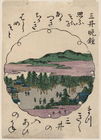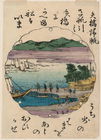Home > Utagawa Toyohiro
Utagawa Toyohiro

Utagawa Toyohiro
The Third Month a Triptych (Sangatsu sanmaitsuzuki) from the series Twelve Months by Two Artists Toyokuni and Toyohiro (Toyokuni Toyohiro ryoga juniko)
Utagawa Toyohiro
No. 4 (from left) from an untitled series of Women Imitating a Daimyo Procession
Utagawa Toyohiro
Returning Sails at Tsukudajima (Tsukudajima kihan) from the series Eight Views of Edo (Edo hakkei)
Utagawa Toyohiro
No. 5 (from left) from an untitled series of Women Imitating a Daimyo Procession
Utagawa Toyohiro
Clearing Weather at Awazu (Awazu seiran) from an untitled series of Eight Views of Omi (Omi hakkei)
Utagawa Toyohiro
No. 2 (from left) from an untitled series of Women Imitating a Daimyo Procession
Utagawa Toyohiro
No. 9 (from left) from an untitled series of Women Imitating a Daimyo Procession
Utagawa Toyohiro
Young Man Painting Fans for Ladies
Utagawa Toyohiro
Evening Bell at Mii Temple (Mii bansho) from an untitled series of Eight Views of Omi (Omi hakkei)
Utagawa Toyohiro
Returning Sails at Yabase (Yabase kihan) from an untitled series of Eight Views of Omi (Omi hakkei)
Toyohiro Utagawa (Toyohiro Utagawa, 3rd year of Anei <1774> --December 21, 1830
Utagawa Toyoharu's master. His real surname is Okajima, commonly known as Fujisaburo. It is called Ichiyanagisai. He was from Edo and lived in Shibakatamonmaecho.
Introduced to Toyoharu and called Ichiyanagisai, and started drawing the picture calendar from around 1788 (Tenmei 8). In the fall of the previous year, there is a fine-sized nishiki-e depicting the second generation Kosagawa Tsuneyo and the third generation Sawamura Sojuro Shigebei, who are believed to be the Kyogen of Nakamuraza. Also known as. The main activity is the illustrations of printed books, and from around the 12th year of Kansei (1800) to the 7th year of Bunka (1810), he mainly worked on the illustrations of the yellow cover, gōkan, and hanashibon of the enemy's defeat. , Santō Kyōden, Takizawa Bakin, and Jippensha Ikku. As a teacher of Hiroshige Utagawa, he also left landscape paintings. The vertical two-sheet series is considered to be Toyohiro's idea. From the 3rd year of Bunka (1806) to the 10th year of Bunsei (1827), he was recognized by Takizawa Bakin and drew many illustrations in his reading book. Representative works of Nishiki-e include "Toyogoku Toyohiro Ryoga 12 Pentads" and "Edo Eight Views". Age 56. The graveyard is Senkoji Temple in Toranomon, Minato-ku. The name of the law is Hidenobu Shaken.
In addition to Hiroshige Utagawa, who is famous as the author of "Fifty-three Stations of the Tokaido", Toyohiro's students include his sons Toyokiyo Utagawa, Hirochika Utagawa, Hirochika Utagawa, Hiroshige Utagawa, Hiromaru Toba, Hirotsune Utagawa, Hiromasa Utagawa. There are Hiromasa Utagawa and Naohiro Utagawa.
